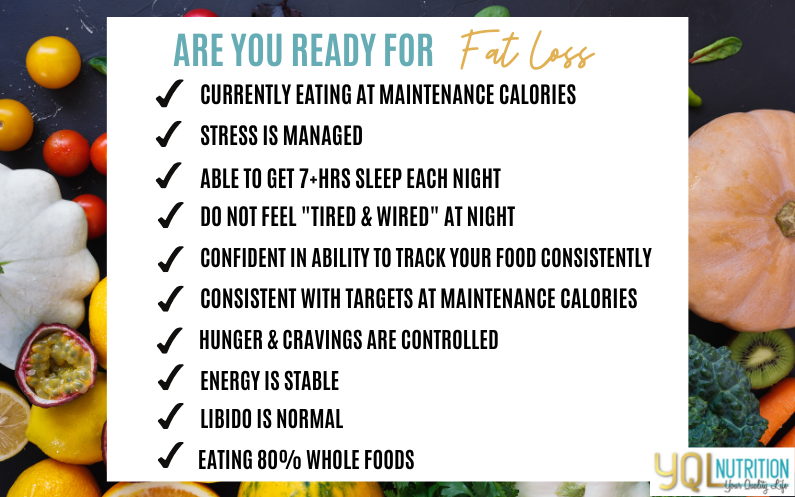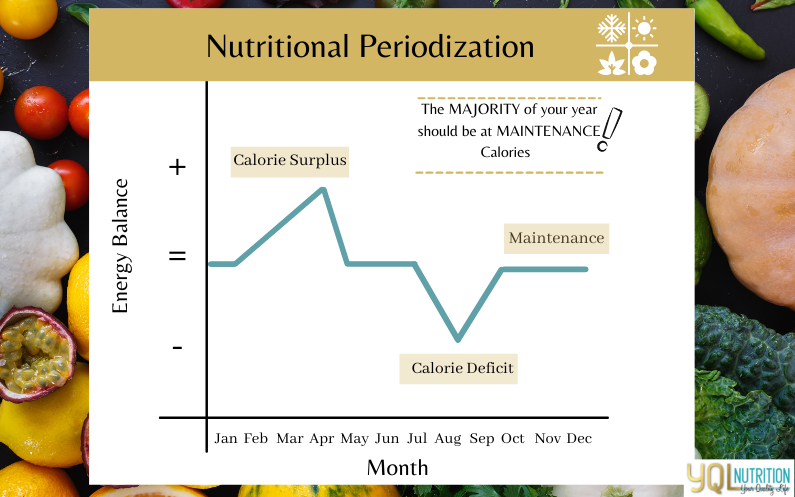All About Energy Balance
We are BACK to chat about the next level of YQL Nutrition’s pyramid for a healthy lifestyle… First, we started with the importance of having a plan that is specific to the INDIVIDUAL, then we looked at the importance of adopting healthy lifestyle habits, and now we are going to chat about ENERGY BALANCE!
What does Energy Balance mean?… and why do I care?
When looking at energy balance, it is evaluating whether energy in (calories/food eaten) is equal to, greater than, or less than energy out (calories burned). The reason this is important is because energy balance can impact a whole lot of things besides just body composition.
Checkout this image below for a quick visual on the different types of energy balance
As the image shows, there are many factors that influence both energy in, and energy out. Both sides of the energy balance equation are complex, and the interrelationships between each side determine body composition and health outcomes. With that being said, let’s dive in further to try to simplify this!
ENERGY IN is influenced by(2):
Appetite: influenced by your hunger hormones. These hunger hormones can get all out of whack with pro-longed negative energy balance, which can increase cravings and hunger potentially leading to more food in… we will dive more into this later!
Food Consumed: Did you know that certain foods are much easier to over-eat? Foods that are highly palatable, such as highly processed or sugary foods trigger us to eat more than nutrient dense whole foods(2). If you are wanting to decrease energy in, try focusing on making the majority of your intake from natural, unprocessed whole foods.
Calories Absorbed: This is a key factor… different individuals have different caloric needs based on age, activity level, and even the state of their gut bacteria(2)! Although “calories in vs. calories out” is a great way to look at energy balance, the ability our body has to absorb nutrients is very individualized(2). This is why trying different approaches to eating can be helpful- some people’s bodies respond better on lower carb diets, others on lower fat. Tracking your food can help you figure out what is best for you!
Psychological Factors: Again, something that is under-rated, BUT did you know that one of the ways you can create positive body composition change is by getting more sleep and reducing stress(1)?! Sleep dramatically impacts hunger hormones, so if you find your appetite has increased recently, you may want to evaluate your SLEEP. In addition, our bodies need to feel SAFE in order to thrive and function properly a high stressed body is not a body that feels safe, and therefore will fight your fat loss efforts. This is why it is important to evaluate and manage lifestyle when chasing any goal, whether it be fat loss, muscle gain, athletic performance, or overall health/wellbeing.
Alright…. So now that we know how to add energy, what influences energy out?!
Energy Out:
Resting Metabolic Rate (RMR): This represents 60% of energy burned(7)… that’s a huge number!! So, while you may be thinking it is your zoomba and spin classes that are burning all of your energy… it mostly isn’t. It is just you, living, breathing, and thinking.
In the image above it mentioned that body composition plays a role in resting metabolic rate… How is this? The leaner you are, AKA the more muscle you have, the more your body burns at rest(7). Muscle tissue is much more metabolically active (requires more energy) than fat tissue is, therefore, if you really want to transform your body into an energy burning machine… focus on building some muscle(7,1)!!
Exercise: Exercise represents 15-30% of energy out MAXIMUM, which in comparison to RMR is quite low( 3,7). This is important to note, as so many individuals focus alot of their efforts on exercise to burn calories, when it is a smaller piece of the puzzle than they may realize.
As you can see, exercise accounts for a relatively small amount of energy output. This is why you want to choose exercise that you ENJOY doing. Exercise is not meant to be about burning, burning, burning calories, but rather, moving your body in a way that honours what it is capable of! As we mentioned, if your goals are related to body composition changes, we do recommend making resistance training the foundation of your training so you can build a body that burns more fat at rest!
Non-Exercise Activity Thermogenesis (NEAT): Checkout this image, it really is quite NEAT! (Please laugh at how punny we are).
As you can see, NEAT accounts for much more energy out then exercise! Some ways to increase NEAT include: Parking the car a few blocks away from your destination, taking the stairs, and standing while you work(1).
Energy Burned by Digestion: So… what you’re saying is… When I eat I burn calories?! Yes! Our bodies require energy to break down food, with certain foods requiring more energy than others. This is called the Thermic effect of food(1,2,3).
The thermic effect of food demonstrates that “a calorie is a calorie” may not be completely accurate when looking at energy balance. If we alter someone’s diet by increasing protein (high TEF), and lower carb intake (lower TEF), we can potentially alter calorie intake and expenditure, thus creating body composition changes(2,3). Human metabolism is complex and although TEF does influence our energy out it is a very small factor. The most important thing when looking at your diet is finding one that you can adhere to long-term so that your lifestyle is in alignment with your goals, but one of the foundational habits we do suggest is eating enough protein for your goals.
Now that we know what effects energy in and energy out, we can look at creating an energy balance that helps us hit out goals, such as maintaining current body composition, optimizing health and wellness, fat loss, muscle building, and athletic performance!
When looking at fat loss, this requires a negative energy balance achieved through a calorie DEFICIT. Think a calorie deficit is right for you… check this out!
When we say biofeedback must be monitored closely during a deficit phase, we mean analyzing how our body FEELS and FUNCTIONS – our sleep, stress, energy, cravings, hunger, mood, and even sex drive!
Have you ever decided to try a new diet and then wondered why your cravings for chocolate, cookies, or other calorie dense foods became super intense? Often times it is because we are creating a negative energy balance that is extreme. Our bodies are SMART and want to help us survive. When we drastically cut calories and create too aggressive of a negative energy balance (calorie deficit), our bodies in turn will respond negatively(4). Our bodies do not know that we are living in a modern society where food is easily accessible. Our bodies only know that calories have decreased, energy is scarce, and it will do whatever it can to help you survive! This is why we want to create as small of a calorie deficit as possible while still getting results- the more food we can diet on while getting results, the better(4)!! Less is often more when it comes to creating a calorie deficit that you can adhere to.
Think you may be ready for a fat loss phase… check out this graphic!
So what if my goal is to build muscle or improve athletic performance? We highlighted how more muscle turns your body into an energy building machine… so how do I accomplish this?!
One approach, may be through a positive energy balance, or calorie surplus!
A POSITIVE energy balance or calorie surplus is when we have more energy/calories coming in then we are expending. Checkout this image to see if this is right for you!
A calorie surplus needs to be utilized with an effective resistance training plan in order to build muscle(1,2). Muscle will NOT be built without a muscle building signal, such as from resistance training(1,2).
Now our FAVORITE phase… MAINTENANCE!
Maintenance calories are when energy balance is EQUAL!
This is the place our bodies are meant to spend the MAJORITY of the year in. Remember how we said our bodies need to be safe to thrive?! This safety occurs in maintenance. Both calorie deficits and calorie surplus can add stress to our bodies, while maintenance is neutral. It is our happy safe little home. Muscle mass can also be gained while eating maintenance calories! Dont underestimate the power of Maintenance Phases… SPEND TIME HERE PLEASE!
If biofeedback (sleep, stress, energy, cravings, hunger, mood, sex drive) is out of whack in any way: from dieting, under-recovering, increased stress, over-consuming food, then maintenance calories is where you should spend some time so it can recover(1,2).
It is important to plan our year so that we are spending the majority of our time in maintenance, with phases in either a calorie surplus, or a calorie deficit(5,6). Doing this, planning your nutrition out for the year according to your goals is called nutritional periodization(5,6)!
Check out this definition:
Now that we know we should be planning ahead… what does this look like?!
Often, as coaches we hear the phrase “I want to get stronger and lose body fat”. And that is a great goal! For most individuals, this is most easily attained through breaking this into two phases: 1. Get stronger,2. Lose fat. Which goal comes first depends on what the client’s current body composition is, and which goal they wish to focus on(5). As coaches, we advise that if a person has a significant amount of weight to lose the focus should be on losing fat FIRST!
Here is an example of how someone can manipulate energy balance throughout the year to hit their goals:
This individual spent 6 months building muscle by starting at maintenance calories and slowly increasing into a calorie surplus to promote optimal muscle building. Next, they spent time at maintenance calories to focus on sleep, stress management, and optimal health. Once they assessed the “are you ready for a fat loss phase” and met the criteria, they began a 3-month fat-loss phase- slowly lowering calories until desired fat loss was achieved, and then reversed calories back up to their NEW maintenance, which may be slightly lower than previous maintenance because their weight is now lower(3,4)
The specific timeline of each phase (fat loss, muscle building, maintenance) is individualized, hence why INDIVIDUALIZATION is the foundation of our pyramid! The right time to do each of the phases is when you believe you will be able to ADHERE best to the energy balance that will help you hit your goal! Specific things to look at when planning your year are events- for example, most individuals do not want to be in a lean-gaining phase on the day of their wedding!
Compliance is the science, and periodizing your year out this way can help promote this!
Energy balance can also be looked at on a smaller scale, such as at a weekly glance.
Are you someone who enjoys eating out or being more flexible on the weekends? Account for this!
Checkout this image to see how energy balance can be manipulated throughout the week to hit your goal!
So, say your goal is fat loss, and a calorie deficit for you is around 1800 calories (this is an example, there is no RIGHT number for a calorie deficit, it is very individual!) But once you know what number you need to be hitting to achieve fat loss, you can choose how to best hit this number by looking at weekly averages!
The two approaches that work best are 1. Hitting close to this number consistently on all 7/7 days. Or 2. Hitting slightly lower calories throughout the week when maybe you’re busy and therefore less hungry, thus creating more room for flexibility on the weekends and having two higher calorie days when you are more social. Both approaches require you to be honest and in tune with yourself- are you someone who likes consistency, or do you know weekends you’d like to have extra calories? By planning ahead, you can create flexibility so that you can enjoy life while still being adherent to your goals! This applies to all phases- fat loss, maintenance, and muscle building!
As you can see, even one or two days slightly higher and then getting back on track does not change the overall average very much. What DOES change the weekly average is having an all-or-nothing mindset- the mindset of “diet starts Monday”… every Monday! Consistency in your approach is ultimately what will determine your success.
We have titled this series “The Hierarchy to a Healthy Lifestyle” because it is meant to be a LIFESTYLE! By understanding energy balance and periodizing your nutrition to match your goals, you can work smarter, not harder! If you find yourself white-knuckling it trying to hit your goals, it may be time to step back and look at what factors are holding you back. This is where the help of a coach can come in: accountability, guidance in the right direction, and support can all be extremely helpful in achieving your goals. If you are interested in chatting with us about your individual goals and how we can help you achieve them, head over to our “Apply for Coaching” Page, we would love to help!
Andrews, R. (2021). All about energy balance. Precision Nutrition. Retrieved from: https://www.precisionnutrition.com/all-about-energy-balance
Berardi, J. (2021). Calories in vs. out? Or hormones? The debate is finally over. Here’s who won. Precision Nutrition. Retrieved from: https://www.precisionnutrition.com/calories-in-calories-out
Chung, N., Park, M. Y., Kim, J., Park, H. Y., Hwang, H., Lee, C. H., … & Lim, K. (2018). Non-exercise activity thermogenesis (NEAT): a component of total daily energy expenditure. Journal of exercise nutrition & biochemistry, 22(2), 23.
Hall, K. D., & Kahan, S. (2018). Maintenance of Lost Weight and Long-Term Management of Obesity. The Medical clinics of North America, 102(1), 183–197. https://doi.org/10.1016/j.mcna.2017.08.012
Jeukendrup A. E. (2017). Periodized Nutrition for Athletes. Sports medicine (Auckland, N.Z.), 47(Suppl 1), 51–63. https://doi.org/10.1007/s40279-017-0694-2
Stellingwerff, T., Morton, J. P., & Burke, L. M. (2019). A framework for periodized nutrition for athletics. International Journal of Sport Nutrition and Exercise Metabolism, 29(2), 141-151.
Von Loeffelholz, C., & Birkenfeld, A. (2018). The role of non-exercise activity thermogenesis in human obesity. Endotext [Internet]














